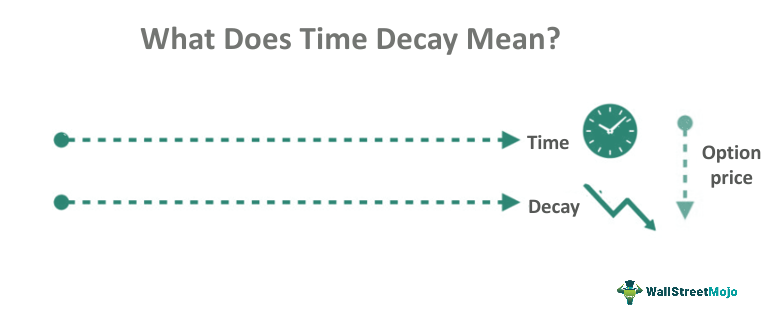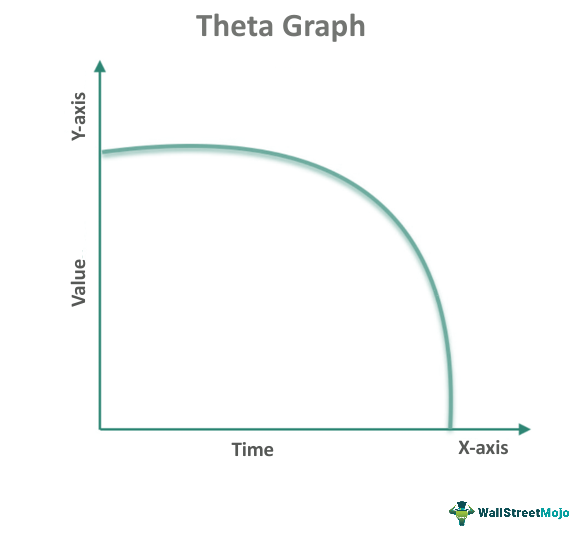Time Decay in Options Meaning
Time decay, also known as theta, in options trading refers to the depreciation in value of an options contract as it nears expiry. The decline in the options contract value is due to the lesser time and reduced probability of the investor making a reasonable profit.

You are free to use this image on your website, templates, etc, Please provide us with an attribution linkHow to Provide Attribution?Article Link to be Hyperlinked
For eg:
Source: Time Decay in Options (wallstreetmojo.com)
The decay of time is inversely proportional to the contract’s time value. With time, the decay process accelerates, and its impact on the options price keeps increasing as it comes closer to expiration. Further, in-the-money contracts suffer less decay as compared to out-of-the-money options contracts.
Table of contents
Key Takeaways
- The time decay model refers to the decline in the price of an options contract as it becomes closer to the expiry date.
- This is due to the diminishing extrinsic value of the options and also due to the decrease in the probability of the investor making a decent return from the investment as the expiry nears.
- Theta is calculated as the ratio of the variation between the strike price and the underlying asset or index price to the expiry period. The use of online options for time decay calculators can be helpful to a great extent.
Time Decay In Options Explained
The time decay model represents the decay of options contract price as it nears its expiry. It is an important concept for individuals and entities investing in options. Investors put their money into instruments expecting a reasonable return. In an investment like options, or any derivatives, for that matter, time is of the essence.
But why do options contracts decay? To understand this, let’s first examine what constitutes the value of options. Intrinsic and extrinsic values are significant components. Intrinsic value is the disparity between the underlying instrument’s strike price and the current market price.
If the strike price and the asset price are the same, the investors will not make any profit. Extrinsic value calculation is more abstract and complex. But it plays a huge role in decay. When decay occurs, the extrinsic value declines before reaching zero on the expiration date.
Moving on to the logical aspect of time decay, as the options contract approaches expiry, there is decreasing probability that the investor will make profits before the expiration date. It is because the decay tends to decrease the options contract’s value.
Investors buying or selling options contracts can keep track of the options time decay chart to be aware and updated on their trading situation. Here’s an example:
| Number of days to expiry | Theta | Time value |
|---|---|---|
| 01 day | Nil | Total |
| 05 days | Very low | Very high |
| 10 days | Low | High |
| 15 days | Moderate | Moderate |
| 20 days | High | Low |
| 25 days | Very high | Very low |
| 30 days | Total | Zero |
Such a chart would enable investors to keep track of their investments and make informed decisions to maximize their gains.
Generally, out-of-the-money options experience more decay as compared to in-the-money options. This is because the former doesn’t have an intrinsic value but only an extrinsic one. When decay occurs, the extrinsic value reaches zero. Therefore, out-of-the-money options contracts lose most of their value on the expiration date. In-the-money options lose less, thanks to their intrinsic value.
Basic and Advanced Derivatives Course
–>> p.s. – If you want to hone your knowledge of Derivatives, then you may consider our “Basics and Advanced Derivatives Bundle Course” (12+ hours of video tutorials). This course covers all the crucial topics to improve your knowledge and understanding of basics to advance derivatives along with awareness as to how derivative instruments work and benefit you.
Formula
Now, let’s study how to calculate Time Decay in Option
Theta = (Strike Price – Stock Price)/Expiry Period
The strike price is the agreed-upon price at which the option contract can be exercised.
The stock price is the market value of the underlying stock/ index.
The value of theta is always negative since it shows a decline and also because time is unidirectional.
Owing to the complexity of the computation, it is better to use options time decay calculators available online.
Calculation Examples
Let’s discuss a few examples to understand the concept better.
Example #1
Here’s a hypothetical calculation example. Bob decided to buy a call option with a strike price of $50. The underlying stock is trading at $45. The contract has an expiration date of 30 days. Let us calculate theta.
Theta = [ 50 – 45 ]/ 30 = 5/ 30
= 1/ 6 dollars
= 16.66 cents
Therefore, the options contract will depreciate by 16.66 cents per day. Bob can maintain an options time decay chart to keep track of his investment.
Example #2
Consider this real-life example of an iron condor trade in Tesla stock. An iron condor strategy involves two puts and two calls (two long, two short). Each has the same expiration date but at four different strike prices. The objective is to make gains from time decay, expecting the price to not move much in either direction.
In the example given in the article, Tesla stock trades at $196.56. A bull put spread would include selling the put option at $160 and buying the put at $155. The bear call spread would include selling the call option at $255 and buying the call option at $260.
Graph
The theta graph is plotted with the value of the options contract (Y-axis) against time (X-axis).

You are free to use this image on your website, templates, etc, Please provide us with an attribution linkHow to Provide Attribution?Article Link to be Hyperlinked
For eg:
Source: Time Decay in Options (wallstreetmojo.com)
As is clear from the graph, the shape of the curve indicates that as time increases, the value decreases.
How To Avoid?
Time decay can definitely be avoided. There are three ways to do so:
- The most natural method is to invest in an options contract with a longer expiry date. This will increase the probability of the trader making a profit.
- Secondly, an investor can sell an option to accompany the one they bought or vice versa. This will lead to compensation in profits, thereby reducing losses.
- Thirdly, an iron condor strategy can be a great technique to protect one’s investments systematically. The trader goes long and short in each of the two puts and calls to minimize losses.
Frequently Asked Questions (FAQs)
Even though futures have an expiration date like options, they are not subject to decay. This might be due to the significance of extrinsic value in option contracts.
A natural way of avoiding or at least reducing the decay in an options contract would be to buy or sell ones with a longer expiry. This will give the trader ample time to make gains and reduces the probability of making losses. A second strategy would be to buy and sell simultaneously to compensate for losses. Thirdly, an iron condor technique is a well-constructed strategy to minimize losses from decay.
In the time decay attribution model, the credit amount is halved after a specific time period has lapsed. And the latest touchpoints receive more credit. It thus gives credit to all the conversion channels.
Recommended Articles
This has been a guide to Time Decay and its meaning. Here, we explain how to calculate and avoid it along with examples and a graph. You can learn more about it from the following articles –


Leave a Reply